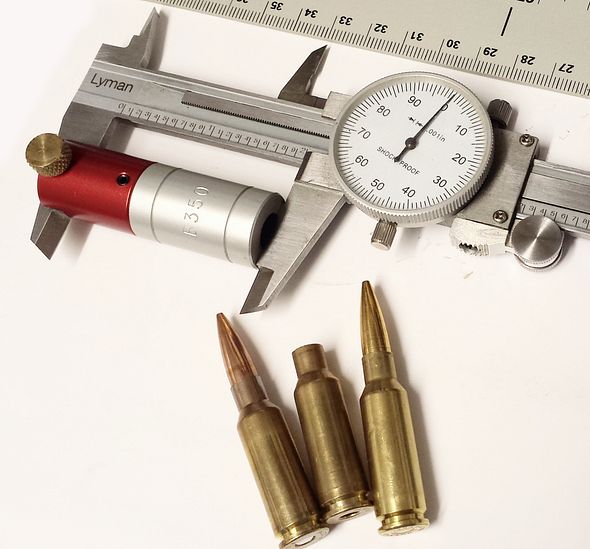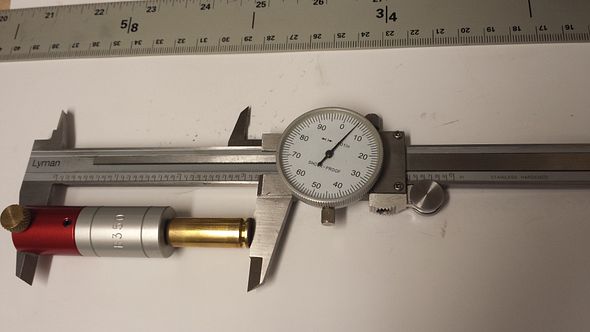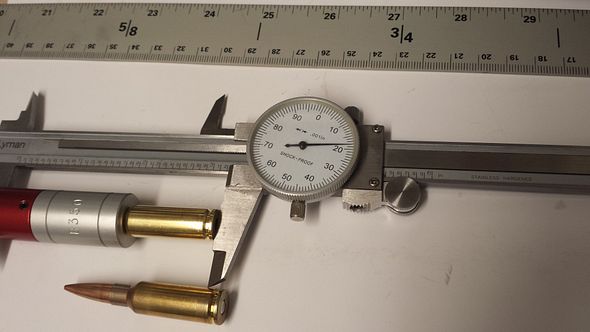So... got an 18" 6 ARC barrel with a rifle gas system, and type II bolt a while back, and finally got around to shooting it not too long ago. It's a new cartridge for me, so I wasn't sure what to expect. I've been using the L.E. Wilson case gauges, along with their case gauge depth micrometer in other cartridges with great results... so I was a little shocked when I dropped a fired case in the gauge and it visibly stood proud of the top  Ran the depth mic down, and it showed it at +11 over '0'. Plunking an unfired factory round in there showed as -3 or so. That range seems... excessive, to me.
Ran the depth mic down, and it showed it at +11 over '0'. Plunking an unfired factory round in there showed as -3 or so. That range seems... excessive, to me.
Like most comparators, that thing is still a 'relative' measurement. I dug out the appropriate shoulder angle insert for my Sinclair headspace comparators, mounted them on the Mitutoyo calipers, and zeroed things out. Loaded round measured 1.128", fired cases measured 1.141" or so. Yikes.
Coughed up the $$$ for a set of go, no-go and *field* gauges in 6 ARC. When they finally arrived, I got the following measurements:
Loaded round: 1.128"
Go gauge: 1.130"
No-go gauge: 1.134"
Field gauges: 1.138"
Fired brass: 1.141"
Then, I went and pulled the upper apart, popped out the ejector pin from the bolt, cleaned the bolt and chamber (never seen that much brass buildup in *either* the bolt or the chamber of my .223 ARs), and found that the bolt would rotate closed on the go gauge (as it should)... but it also closed on the no-go gauge, and damn near closed on the field gauge.
I double checked the depth of the bolt face; it is a type 2 (0.136" deep) bolt.
I'm guessing this isn't supposed to be the 'normal' amount of shoulder stretch on firing factory ammo in a 6 ARC barrel?
Any ideas what might be the likely culprit here? Chamber set up for a type 1 bolt (0.125" deep) instead of a type 2? Seems like that would almost account for the difference I'm seeing here. Or more likely the chamber is just f$cked up, some other way?
The fired brass coming out measuring longer than the chamber is another one that had me going 'WTF?!?' Someone else suggested that it might point towards a gas system issue, with the bolt trying to unlock before the pressure has dropped enough for the case shoulder to release from the chamber walls.
Like most comparators, that thing is still a 'relative' measurement. I dug out the appropriate shoulder angle insert for my Sinclair headspace comparators, mounted them on the Mitutoyo calipers, and zeroed things out. Loaded round measured 1.128", fired cases measured 1.141" or so. Yikes.
Coughed up the $$$ for a set of go, no-go and *field* gauges in 6 ARC. When they finally arrived, I got the following measurements:
Loaded round: 1.128"
Go gauge: 1.130"
No-go gauge: 1.134"
Field gauges: 1.138"
Fired brass: 1.141"
Then, I went and pulled the upper apart, popped out the ejector pin from the bolt, cleaned the bolt and chamber (never seen that much brass buildup in *either* the bolt or the chamber of my .223 ARs), and found that the bolt would rotate closed on the go gauge (as it should)... but it also closed on the no-go gauge, and damn near closed on the field gauge.
I double checked the depth of the bolt face; it is a type 2 (0.136" deep) bolt.
I'm guessing this isn't supposed to be the 'normal' amount of shoulder stretch on firing factory ammo in a 6 ARC barrel?
Any ideas what might be the likely culprit here? Chamber set up for a type 1 bolt (0.125" deep) instead of a type 2? Seems like that would almost account for the difference I'm seeing here. Or more likely the chamber is just f$cked up, some other way?
The fired brass coming out measuring longer than the chamber is another one that had me going 'WTF?!?' Someone else suggested that it might point towards a gas system issue, with the bolt trying to unlock before the pressure has dropped enough for the case shoulder to release from the chamber walls.




